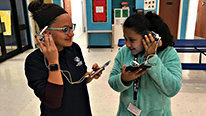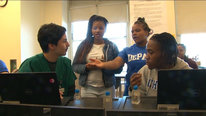- Robert Reardon
- Integrating the Computer Science and Computational Thinking in Three Rural Eastern North Carolina School Districts
- East Carolina University
- Anne haugh
- teacher
- Integrating the Computer Science and Computational Thinking in Three Rural Eastern North Carolina School Districts
- iCS4All Chinquapin Elementary
Public Discussion
Continue the discussion of this presentation on the Multiplex. Go to Multiplex








Gerad OShea
Research Director
As a former band director, I love to see the A in STEAM!
Are there any generalizable lessons or best practices you learned from adapting the Barefoot initiative into these visual arts classes?
Thanks,
Gerad
Robert Reardon
Gerad:
Barefoot's conceptualization of computational thinking (CT) as embracing a set of concepts that could be explored by a set of approaches appealed to us because of its operational orientation.
That appeal has been borne out in practice. I'll confess that, initially, I thought it might be a challenge to integrate CT into visual arts, but, harnessing the wisdom of our art teachers to our enthusiasm, we have found it remarkably easy to do so. We devised a "curricular activity system" booklet to guide our baby steps and we will be revising this over the coming summer.
BTW: If you haven't already done so, I encourage you to visit the Barefoot site Barefoot Computing website
Gerad OShea
Research Director
Thanks, Robert. After watching the video it's clear that CT has a natural application in visual arts, so hats off to your team for this creative integration!
I'm curious about what medium the students used to create their abstractions. Was it done with paper or using software? If software, can you share which one and the general level of creative expression kids have?
Alana Zambone
This project has done so much to increase students' knowledge and skills in computation and computational thinking in a way that stokes their enthusiasm for learning and their creativity! Hats off to the teachers and students and families and ECU College of Education Faculty for an exciting and effective project and for all of the work you have put into it. Your results are speaking for the quality of the teamwork and effort you have put into this!
Gerad OShea
Robert Reardon
Many thanks, Alana. It is in no small part as a result of your support and that of your colleagues that we have been able to achieve as much as we have.
Jennifer Mendenhall
As an ECU alum who has gone on to take a deep dive into how we communicate in science, I can't say enough about the importance of "A" in STEAM. Sense making and visual thinking go hand in hand. Though likely out of the original scope of the project, I'm curious to know if you are seeing the benefit of this project expand into other subjects?
Robert Reardon
While it hasn't been a priority for us, we have asked students the question in focus groups whether the CT skills they learn with "us" transfer to other subjects. Being keen to please us, they generally say "sure" in that vague way that probably should be interpreted as "I have no idea."
BUT, one of the side projects in which we are interested is developing an instrument to assess CT that might be pertinent across subjects. Any suggestions are most welcome.
Jennifer Mendenhall
It seems to me that STE(A)M education is a great place to start with building the connections to CT because the connections are inherent. Layering on a CT framework feels like a great way to help students see the connections across subjects. I'd be excited to hear how it plays out!
Robert Reardon
Loved to see your use of the term "layering." One of the curricular activities with which the students are invited to engage drew its inspiration from palimpsests--which, of course, are artifacts of the layering process. One thing is so clear in our project is how much value is added from the expertise of the teachers with whom we are privileged to work. We are revising the curricular activities over the summer, and we are seeking to recruit another district to join us in the fall. Our project is playing out in wonderful and gratifying ways--and we hope it will continue to do so!
Kirsten Daehler
Feng Liu
Researcher
Thanks for sharing this interesting work! I would like to know more about the project from an evaluation perspective. Could you share more information about the outcomes of interest (e.g., student computational thinking skills, interest in the subject matter), the type of data collected, and instruments used for data collection?
Robert Reardon
One of the things that we knew we wanted to avoid was somehow evaluating the quality of the art work that the students produced. After some head scratching, I came up with the idea of inviting the students to self assess after each curricular activity and sub-activity (there are eight curricular activities and varying numbers of sub-activities) regarding the extent to which they were engaging with logic, algorithms . . . (the six concepts--we discuss on an ongoing basis what the concepts mean--the Barefoot descriptions are very helpful thumbnail reminders to them and to us).
This has proven to be a most interesting exercise, as we synthesize the students' feedback by means of a modified bar chart and then invite them to reflect on the synthesis. We have also conducted a Q sort with them to get a "read" on how their perceptions relate to their grades in the subject, and we are planning to extend into assessing engagement and motivation next year.
Some of the students are very forthright in declaring how much they enjoy art (as you will have seen from the video), although it is challenging to disentangle the impact of our approach from the students' instinctive liking for art.
Feng Liu
Researcher
Thanks for sharing the details on student learning assessment!
Lou Hardee
This is a great project and I enjoyed the presentation!
Robert Reardon
Many thanks, Lou.
Hilary Kreisberg
Hi,
This was a great presentation - I always love seeing students think! With regard to the focus groups you ran, could you explain the protocol and how you structured these? We are looking to do the same in our project, so your response could be very helpful!
Gerad OShea
Robert Reardon
Happy to share what we did, Hilary. The focus groups have been one of the most straightforward parts of the evaluation process, although there definitely is a level of skill involved. For a start, I had the advantage of two GAs who were in their final year of the ECU's Marriage and Family Therapy program, so they were well versed in listening and developing probing questions on the fly. That said, we brainstormed prior to any focus group to develop a set of six (no more!) prompts that we think are pertinent. The question that you see Claire ask in the video about "do you guys enjoy coming to art?" was one of the six prompts for that focus group, but the instant response highlights what I regard as the "essential skill"--how she snuck it into the conversation. If I had asked the same question, it probably would have been greeted with a yawn!
Nancy McGowan
Instructional Math Coach
I enjoyed the video so much and LOVE the creative connection between computer science and art that you have established. Where have you seen the greatest student impact through this integration?
Robert Reardon
You will have seen from the video the impact that our project has made on Anne herself! As for the students, I see the greatest impact in terms of the self-confidence of the students in speaking about computational thinking. For example, one of the major activities we conducted earlier this year was a "tri-county community learning exchange." (Shades of Harry Potter!). This event drew together some 40 parents and civic partners from across the three counties in which our project takes place. One of the students in one of the classes integrating CT with music delivered a most impressive expose of the concepts of CT in response to a question from one of the middle school principals. She then calmly asked whether there were any more questions! I'll vote for her!
Daniel Niece
Love the "Approaches" and the Abstraction! We use a ton of the mentioned concepts in our Art room at J H Rose High School here in Pitt County! Thanks for sharing this Visual information!!
Robert Reardon
Thank you for sharing your approaches with us in the early days of our project and for staying with as on the learning journey.
Fay Shaw
Awesome work! It's great to see projects that incorporate Computational Thinking without coding as the primary focus.
Robert Reardon
As you do yourself, Fay! We hope to return to exploring e-textiles at one of our sites in the fall.
Mike Ryan
I can see how you are taking study of the natural world and then converting those images (the pelican or purple rose) and events (the claymation) into visual art. But I'm wondering if you have explored or investigated how the design and creation of the art pieces has affected students' understanding of the science content, practices or crosscutting concepts? Are they learning something further or new about the science from the art, that they otherwise would not have learned without the art?
Anne haugh
teacher
I believe that the investigative approach that I have used throughout the varied lessons has undoubtedly impacted some of the students. The subject itself, may not carry over into other disciplines, but my hope is that they are processing information and becoming more investigative in other subjects as well The students are asked to evaluate their use of CT in the different projects as well as how it impacts their work in other classes and data collection is ongoing.
Robert Reardon
Thanks for your thoughtful pondering. We would be more than happy if the students transferred the concepts and approaches that we see them exploring and implementing in music and visual arts in any or all of their other academic pursuits. The student who described himself as waxing enthusiastic about art in his math class in the video is actually very good at math--but that was the case long before we began our project. We are focused on integrating CT (adopting Barefoot's definition of what that means) into music and the visual arts. We don't delve into how the concepts and approaches pertain to other fields--such as computer science, for instance.
Dale Mann
Discrepant, provocative, promising. Another way to connect thinking and communities that don't often overlap. It was said of Darwin, "He saw what everyone saw and he thought what no one thought." The Galapagos come to Greenville?
Keep doing good, Martin
Further posting is closed as the showcase has ended.